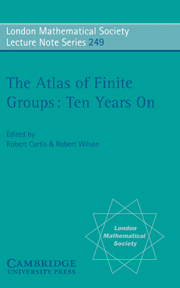Book contents
- Frontmatter
- Contents
- Introduction
- Addresses of registered participants
- Addresses of non-participating authors
- Programme of lectures
- Conference photograph and key
- Symmetric presentations and orthogonal groups
- A constructive recognition algorithm for the special linear group
- Relations in M666
- A survey of symmetric generation of sporadic simple groups
- Harish-Chandra theory, q-Schur algebras, and decomposition matrices for finite classical groups
- The Meataxe as a tool in computational group theory
- Branching rules for modular projective representations of the symmetric groups
- Characters and surfaces: a survey
- On the characterization of finite groups by characters
- Finite linear groups of small degree
- Minimal parabolic systems for the symmetric and alternating groups
- Probabilistic methods in the generation of finite simple groups
- Condensing tensor product modules
- Intersections of Sylow subgroups in finite groups
- Anatomy of the Monster: I
- An integral ‘Meat-axe’
- Finite rational matrix groups: a survey
- Chamber graphs of sporadic group geometries
- An Atlas of sporadic group representations
- Presentations of reductive Fischer groups
- A brief history of the ATLAS
Symmetric presentations and orthogonal groups
Published online by Cambridge University Press: 19 May 2010
- Frontmatter
- Contents
- Introduction
- Addresses of registered participants
- Addresses of non-participating authors
- Programme of lectures
- Conference photograph and key
- Symmetric presentations and orthogonal groups
- A constructive recognition algorithm for the special linear group
- Relations in M666
- A survey of symmetric generation of sporadic simple groups
- Harish-Chandra theory, q-Schur algebras, and decomposition matrices for finite classical groups
- The Meataxe as a tool in computational group theory
- Branching rules for modular projective representations of the symmetric groups
- Characters and surfaces: a survey
- On the characterization of finite groups by characters
- Finite linear groups of small degree
- Minimal parabolic systems for the symmetric and alternating groups
- Probabilistic methods in the generation of finite simple groups
- Condensing tensor product modules
- Intersections of Sylow subgroups in finite groups
- Anatomy of the Monster: I
- An integral ‘Meat-axe’
- Finite rational matrix groups: a survey
- Chamber graphs of sporadic group geometries
- An Atlas of sporadic group representations
- Presentations of reductive Fischer groups
- A brief history of the ATLAS
Summary
Abstract
In this paper we examine series of finite presentations which are invariant under the full symmetric group acting on the set of generators. Evidence from computational experiments reveals a remarkable tendency for the groups in these series to be closely related to the orthogonal groups. We examine cases of finite groups in such series and look in detail at an infinite group with such a presentation. We prove some theoretical results about 3-generator symmetric presentations and make a number of conjectures regarding n-generator symmetric presentations.
Introduction
Symmetric presentations have been much studied over a long period; see for example [1, 9, 10, 14, 23], which focus on symmetric relations. An alternative approach, directed towards symmetric generating sets, is taken by Curtis [11, 12, 13].
Suppose G is a finite 2-generator group with generators x1,x2 and an automorphism θ with x1θ = x2 θ and θ2 = 1. Then G has a symmetric presentation
Note that any finite non-abelian simple group has such a symmetric presentation. For, if G is a finite non-abelian simple group, then G = 〈a, b〉 where a2 = 1 [19]. Now consider H = 〈b, ba〉 ≤ G. Either G = H or |G : H| = 2. But G is simple, so G = H = 〈b, ba〉 and hence G has a symmetric presentation.
Recently Miklos Abert (unpublished) has generalized the results of [14] and conjectures that, given any non-trivial group G, then G has a presentation which, when symmetrized, presents a non-trivial image of G. The above comment on symmetric presentations for simple groups is a consequence of the results of Abert.
- Type
- Chapter
- Information
- The Atlas of Finite Groups - Ten Years On , pp. 1 - 10Publisher: Cambridge University PressPrint publication year: 1998
- 1
- Cited by

